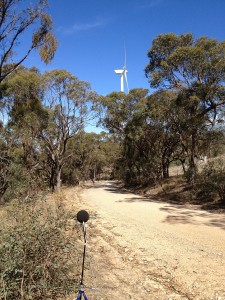Wind farms

The proliferation of wind farms in Australia has led to a significant number of complaints from communities in proximity to such wind farms, covering a wide range of symptoms including nausea, headaches, sleep disturbance, inability to watch television or communicate and in extreme cases causing people to leave their homes.
The selection of acoustic criteria for the purpose of wind farms has not been based on scientific studies in Australia, but has utilised criteria from overseas (primarily based on road traffic) and using a base level different to the generalised concept adopted by various authorities of assuming for the purpose of industrial noise sources a default background level of 30 dB(A) in rural environments.
Whilst wind farms are located in areas that are sparsely populated the extent of complaints associated with wind farms indicates, from a noise perspective, that the controls in place are ineffective and/or the planning criteria is unacceptable to rural communities.
In conducting a review of an application concerns were expressed in terms of the lack of scientific rigour for the development of criteria for the Australian environment and that complaints from residents could not be explained when there was ‘compliance’ with the nominated criteria, as the generalised dB(A) parameter does not appear to adequately protect people. The evaluation of such concerns had led to further investigations that have raised even more questions.
Utilising instrumentation far superior to standard sound level meters, our testing revealed the presence of a periodic signature in the infrasound region, being frequencies below 20 Hz.
Our investigations into operational wind farms have repeatedly found this infrasound signature from turbines contains a fundamental frequency (identified as the blade pass frequency, being the number of blades passing the tower every second) and multiple harmonics of the blade pass frequency (typically up to the order of 10 harmonics). Mr Cooper identified this harmonic pattern as the “Wind Turbine Signature “and has since identified the presence of that signature at operational wind farms, at residential locations where residents have indicated they have been adversely affected, and at times inside dwellings.
The results of our measurements in relation to wind farms has identified that more investigations are required in that our testing has established the following:
- despite the claims by various Regulatory Authorities that infrasound is not generated by well-maintained wind farms, our testing has identified an infrasound signature is generated and continues past the boundaries of the wind farm,
- the infrasound signature has been identified at residential receivers,
- the infrasound when analysed in narrow bands reveals the fundamental frequency associated with the blade pass frequency and multiple harmonics of that frequency,
- the wind turbine signature can be detected at distances significantly removed from the wind farm with measurements revealing the Wind Turbine Signature pattern 8 km from one wind farm in South Australia,
- infrasound is not necessarily a noise that can be detected by residents both inside and outside dwelling, but the infrasound signature is observed when residents detect a perception of the operating wind farm,
- plotting ambient background levels versus the power output of a wind farm between the operational wind farm and the background level. However, the Cape Bridgewater study found correlation of the LAeq level to the wind noise – not the wind farm.
- there are difficulties in determining compliance/non-compliance of a wind farm where conditions of consent are expressed in terms a wind speed at the hub height, particularly when the hub-height wind speed is not available,
- ambient background levels in rural communities can at some locations during the day and many locations at night are less than 20 dB(A). Similarly, noise levels in dwellings at night can be less than 15 dB(A),
- from spectral information recorded at residential dwellings it is clear the A-weighted curve underestimates the impact of the low-frequency sound,
- The use of the G weighting curves that are related to audibility of infrasound do not appear to be relevant to the majority of infrasound energy generated by industrial wind turbines as the levels are well below the “nominal” inaudibility limit of 85 dBG. The perception of infrasound may well be addressed by a different weighting covering such frequencies.
- there is no dose-response curve available for Australian communities impacted by wind farms to determine the acceptable noise limit for wind farms in rural environments.
Interchange of information with other acousticians undertaking measurements in rural communities near wind farms reveals questions as to the suitability/capability of the instrumentation use to measure wind farm and ambient noise. Extensive testing in our hemi-anechoic room has led to the elimination of generalised microphones/instruments for the measurement of such levels.
Similarly, issues in relation to the dynamic capability of instrumentation, both in terms of amplitude and frequency, of microphones used for the measurement of wind farm noise has been questioned both in our laboratory and in field measurements using simultaneous multi-channel measurements.
As a result of our investigations seeking to understand complaints in relation wind farms we have been requested to undertake reviews of various applications, together with the presentation of evidence for proceedings, pertaining to factual material recorded at wind farms in Australia.
Mr Cooper was invited by the Acoustical Society of America to be a member of the Wind Turbine Working and present papers on his research into wind turbine noise.
A significant issue, during the course of our investigations in a number states of Australia, raised by the community as to ethical behaviour acousticians concerning wind farm noise and that led to our principal Mr Cooper preparing an article in relation to ethics.
The actual noise impact of operational wind farms is not normally identified in such assessments and is still a matter of further research work and presentation of data for the basis of discussion/education of the acoustic fraternity.
There is still much to go in defining/addressing the acoustic impact of wind farms and appropriate criteria to protect the interests of the community in proximity to such developments.
In late 2014 the Firm completed an extensive noise study at Cape Bridgewater Wind Farm to assess resident’s disturbance relative to certain wind speeds and certain sound level, notwithstanding ‘compliance’ with the permit conditions.
Our investigations involved inside and outside measurements at residences, measurements on the wind farm and includes correlation of diary observations – all with the full cooperation of the wind farm and the residents.
A resident survey format included sensation as one of the observations. For the specific local residents involved in the study sensation as the major source of complaint. The wind turbine signature has been found to be relevant to the observations and a component of the acoustic environment near an operating wind farms that is not there when the wind farm is shutdown. The Cape Bridgewater report has been released and contains extensive range of data analysis including a suggested metric the “dB(WTS)” to assist in further studies.
Further investigations undertaken by TAG has found the presence of pulsations across the entire acoustic signature at receiver locations (external and internal) where the pulsations occur at the blade pass frequency of the turbines. This work has questioned the generation of infrasound and the sensation/perception of people sensitised to such noise, particularly when such energy occurs at or below the nominal threshold of hearing.
An examination of the timing of the pulsations has led to the concept of dynamically pulsed amplitude modulation and identified an issue of non-compliance with the analysis requirement of BT=1.
An extension of the work to include other sources of industrial noise that exhibit infrasound/low frequency noise pulsations has identified a pattern of disturbance associated with changes in power output of the facility, similar to that identified at Cape Bridgewater.
In 2018 Mr Cooper was appointed to the Technical Committee Noise of the European Acoustics Association as group leader on wind turbine noise.
Some Relevant Papers:
“Wind Farm Noise – An ethical dilemma for the Australian Acoustical Society?”, Acoustics Australia, Vol 40, No. 2, August 2012
“Are Wind Farms too Close to Communities?”, Australian Environment Foundation 2012 Annual Conference, October 2012
“The Measurement of Infrasound and Low Frequency Noise for Wind Farms (amended version)”, 5th International Conference on Wind Turbine Noise, Denver 2013
“Hiding Wind Farm Noise in Ambient Measurements – Noise Floor, Wind Direction and Frequency Limitations”, 5th International Conference on Wind Turbine Noise, Denver 2013
“Sensation As An Impact From Wind Turbines”, 169th Meeting of the Acoustical Society of America, Pittsburgh, May 2015
“The Cape Bridgewater Wind Farm Study – Sensitisation, and Cause & Effect”, Acoustical Society of America Meeting, Pittsburgh May 2015
“Soundscape of a Wind Farm – The Cape Bridgewater Experience”, Acoustical Society of America Meeting, Jacksonville, November 2015, ASA POMA vol 25/1/10.1121/2.0000157
“Wind Farm Infrasound – Are we measuring what is actually there or something else?” Acoustical Society of America Meeting, Jacksonville November 2015, ASA POMA vol 25/1/10/1121/2.00001777
“Reproducing wind farm infrasound for subjective testing – Just how accurate is the reproduced signal?”, Acoustical Society of America, Salt Lake City, May 2016
“Wind Farm Infrasound – Are we measuring what is actually there or something else? (part 2)”, Acoustical Society of America Meeting, Salt Lake City, May 2016 (Slide Presentation: “Wind Farm Infrasound Part 2”)
“Threshold of hearing v threshold of sensation for low frequency and infrasound” ,Acoustical Society of America Meeting, Salt Lake City, May 2016
“Wind Farm Infrasound – Are we measuring what is actually there or something else? (part 3)”, Acoustical Society of America Meeting, Hawaii, December 2016
“Can inaudible and audible low level infrasound and low frequency noise be an acoustic trigger of the startle reflex?”, Acoustical Society of America Meeting, Hawaii, December 2016
“Reproduction of wind turbine infrasound and low frequency noise in a laboratory”, Acoustical Society of America Meeting, Boston, June 2017
“Subjective perception of wind turbine noise”, Acoustical Society of America Meeting, Boston, June 2017, ASA POMA Vol 30/10.1121/2.0000639
“Are Sample Rates for Wave File Recordings Too Low for Transient Signals?,” Acoustical Society of America Meeting, Boston, June 2017
“Subjective perception of wind turbine noise – The stereo approach”, Acoustical Society of America Meeting, New Orleans, December 2017, ASA POMA Vol 31/10.1121/2.0000653
“Acoustic Compliance with Permit Conditions – What does it Mean?”, Acoustical Society of America Meeting, New Orleans, December 2017
“The Inaudible Soundscape of a Wind Farm”, Euronoise2018, Crete, May 2018
“The use of synthesized or actual wind turbine noise for subjective evaluation purposes”, 23rd International Congress on Acoustics, Aachen Germany, September 2019
“A simplified method of determination of “amplitude modulation” of audible and inaudible wind turbine noise”, 23rd International Congress on Acoustics, Aachen Germany, September 2019
“A comparison of inaudible windfarm noise and the natural environment noise whilst monitoring brainwaves and heart rate.” 23rd International Congress on Acoustics, Aachen Germany, September 2019
